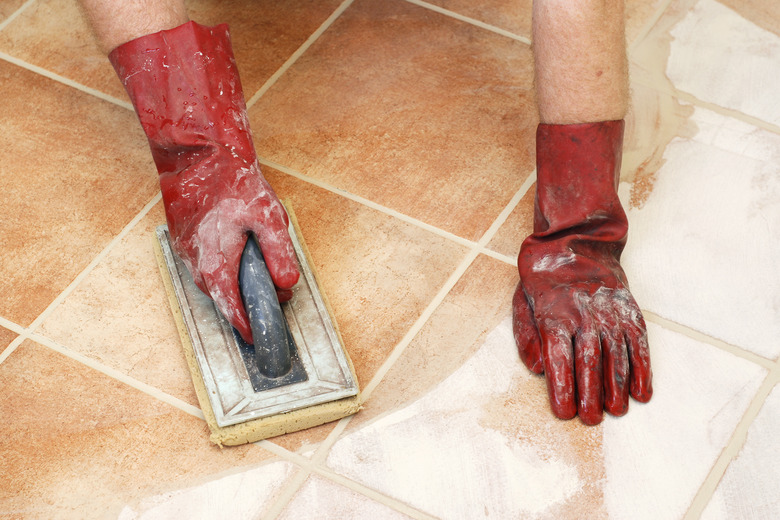How To Fix Grouting Mishaps
Every tiled surface in your home was grouted and may need re-grouting at some point in time. Grout is integral to every tile installation, protecting the edges of the tiles from damage and keeping moisture from reaching the substrate below the tiles. Unfortunately, there are numerous ways that a grout installation can go wrong. From grout of the wrong consistency to grout that dries too soon, grout mishaps need fixed quickly to ensure a long-lasting installation.
Grout Consistency
Grout Consistency
Properly mixed grout has the consistency of slightly runny creamy peanut butter. When scooped onto the end of a grout float, it should stay put rather than dripping or running back into the bucket. Grout is frequently mixed up too wet and doesn't cure properly when applied. Soggy grout leaves the finished joints weak and prone to cracking or crumbling, as well as to efflorescence, a chalky, white appearance. If your grout is runny or too wet, add additional dry grout to the mixture until it reaches the proper consistency for use.
Although much less common, it is possible to mix grout too dry. Overly dry grout is difficult to stir and crumbles. Simply add a bit of water to fix the consistency of dry grout.
Weak, Cracked or Insufficient Grout
Weak, Cracked or Insufficient Grout
Too much water in the grout or too much water in the sponge as you clean the grout may result in a partially-filled or weak grout joint. There may be holes, cracks or gaps in the grout lines, which can weaken the integrity of the joint and allow moisture to penetrate beneath the tiles.
While it is tempting to simply apply more grout, new grout may not bond properly to grout that has already cured. To fix this problem, you can try wetting down the existing grout and applying a new grout over it. The new grout should adhere to the wet grout, but if it doesn't, you'll have to dig the old grout out with a utility knife or a grout saw. Clean the joint well with denatured alcohol to remove any remaining grout residue, then re-grout the joint.
Excess Grout Removal
Excess Grout Removal
Grout begins to cure within 10 minutes of application. It dries to a hard finish within 24 hours, but does not completely cure, or harden to its final strength, for up to three weeks.
If you applied too much grout to the tiles or got interrupted while working and left grout dry on the tiles, you can fix the problem if you act quickly. Within a few days, scrape as much of the excess grout off the tiles as possible using the sharp end of a paint stick or other piece of wood with a sharp edge or angle. Soak the remaining grout in a mixture of one part sugar to six parts water until the grout softens enough for easy clean-up.
Hazy Tiles and Grout
Hazy Tiles and Grout
No matter how successful your tile job went, you may discover a film of dried grout on your tiles the day after grouting them. Pros call this problem grout haze, and if you have it, sometimes your grout looks chalky as well as your tiles. Grout haze is tiny particles of the Portland cement left behind during the cleaning job. If attended to within a day or two of installation, grout haze wipes off easily with a dry towel. Crumple a paper or microfiber towel — or a piece of cheese cloth — in your hand and work it in circles over the tile to wipe the haze away.
Sealing Grout for Protection
Sealing Grout for Protection
If you have used a cement-based grout rather than an epoxy-based one, prevent another kind of problem before it occurs by sealing the grout. You can seal grout any time once it has fully cured, which takes at least three weeks. Not sealing your grout could lead to staining or mildew buildup. Clean your grout well to remove any surface stains or mildew, then apply an impregnating sealer to the grout once yearly to protect it from stains.
